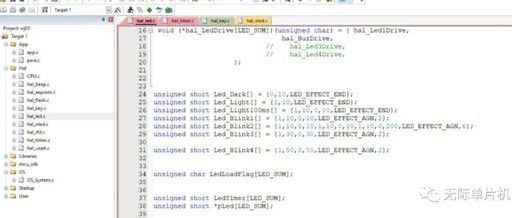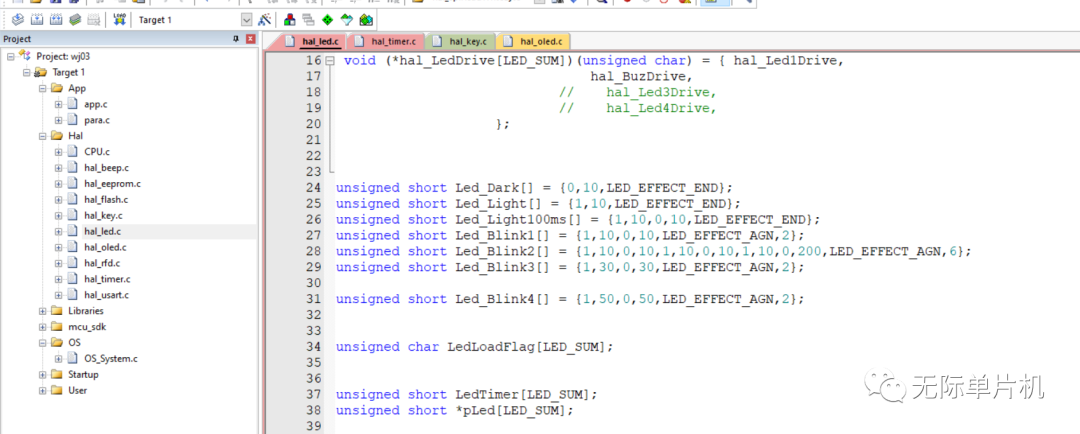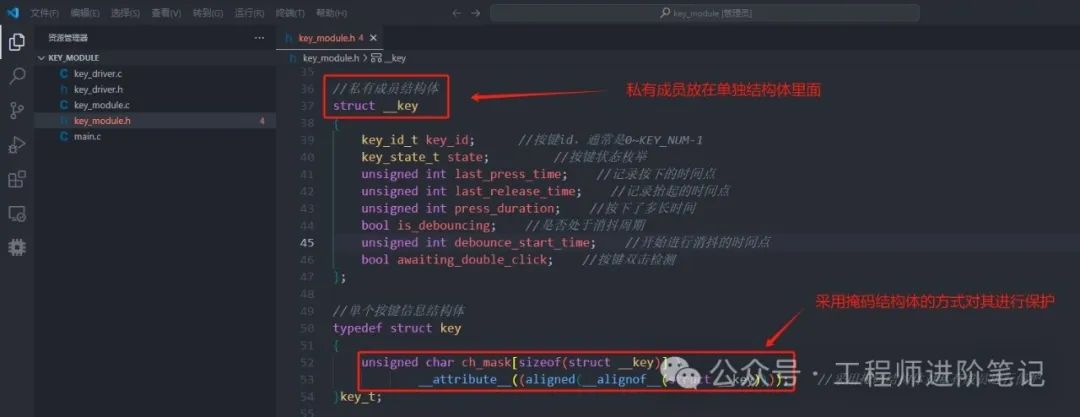大部分使用 C 语言进行开发的工程师,在接触更高级的编程语言之前,都认为 C 语言是面向过程的。确实,对于一些小规模的应用程序,C 语言一般都被用作面向过程编程。例如:单片机应用程序开发。
但是,如果是使用 C 语言开发一些规模较大的软件时,就必须用面向对象的思想去考虑和设计整个软件框架了。例如:嵌入式Linux操作系统。
嵌入式Linux操作系统虽然是使用 C 语言作为主要的编写语言,但里面的设计大部分都使用了面向对象的编程思想。很多单片机工程师或者嵌入式Linux驱动初学者,觉得入门困难,很大一部分原因就是,他们还停留在单片机那种面向过程的思维模式上面。
编程语言只是一种工具,编程思想才是用好这个工具的关键。C 语言只是工具,而面向对象是一种编程思想,用来指导我们如何用好 C 语言。
接下来,我们将尝试使用 C 语言进行面向对象程序开发,务求使用 C 语言实现面向对象的一些基本特性。
首先,我们先来说说封装。
封装就是把一个抽象事物的属性和属性的操作函数打包在一起,外界的模块只能通过这个抽象事物对外提供的函数接口,对其属性进行访问。在C 或其他高级语言中,封装通常被称作“类”。而 C 语言一般使用结构体对事物进行封装。
接下来,我们先看两段代码,这两段代码主要声明和定义了一个坐标类对象,以及其坐标属性,还提供坐标属性的操作函数。
头文件 coordinate.h
#ifndef __COORDINATE_H_#define __COORDINATE_H_
//声明一个位置类,属性为坐标x,ytypedef struct coordinate{ short int x;
short int y;}COORDINATE_T,*P_COORDINATE_T;
extern P_COORDINATE_T coordinate_create(short int x,short int y);
extern void coordinate_destroy(P_COORDINATE_T p_coordinate);
extern void coordinate_moveby(P_COORDINATE_T p_coordinate,short int dx,short int dy);
extern short int coordinate_get_x(P_COORDINATE_T p_coordinate);
extern short int coordinate_get_y(P_COORDINATE_T p_coordinate);
extern void coordinate_test_function(void);#endif // !__COORDINATE_H_
源文件 coordinate.c
#include "stdio.h"#include "stdlib.h"#include "string.h"#include "inc/coordinate.h"
//创建一个coordinate对象P_COORDINATE_T coordinate_create(short int x,short int y){ if((x < 0) || (y < 0)){ printf("coordinate creat error! x or y can not be less than zero
"); return NULL; }
P_COORDINATE_T p_coordiante = NULL; p_coordiante = (P_COORDINATE_T)malloc(sizeof(COORDINATE_T));
if(NULL != p_coordiante){ p_coordiante->x = x; p_coordiante->y = y; } else printf("coordinate malloc error!
"); return p_coordiante;}
//销毁一个coordinate对象void coordinate_destroy(P_COORDINATE_T p_coordiante){ if(NULL != p_coordiante){ free(p_coordiante); p_coordiante = NULL; }}
//修改coordinate的属性值void coordinate_moveby(P_COORDINATE_T p_coordiante,short int dx,short int dy){ if(NULL != p_coordiante){ p_coordiante->x = dx; p_coordiante->y = dy; }}
//获取coordinate的属性值xshort int coordinate_get_x(P_COORDINATE_T p_coordiante){ return (NULL != p_coordiante) ? p_coordiante->x : -1;}
//获取coordinate的属性值yshort int coordinate_get_y(P_COORDINATE_T p_coordiante){ return (NULL != p_coordiante) ? p_coordiante->y : -1;}代码比较简单,在头文件 coordinate.h里面,通过结构体封装了一个coordinate类,里面有两个坐标属性 x 和 y 。
coordinate_create 函数主要用于创建一个 P_COORDINATE_T 类型的对象,并为其分配内存空间,内存分配成功后,设置两个坐标属性的初始值,最后返回申请成功的对象指针。
coordinate_destroy 主要是释放对象之前申请的内存空间,然后把对象指针重置为NULL。
其他的操作函数,主要是对类对象的属性进行操作,比如获取 x 和 y 的属性值,重置坐标的属性值。
以下是测试函数,在主函数中调用,即可测试类coordinate对外提供的接口
void coordinate_test_function(void){ P_COORDINATE_T p_coordiante_1 = NULL;
P_COORDINATE_T p_coordiante_2 = NULL;
p_coordiante_1 = (P_COORDINATE_T)coordinate_create(100,200);
p_coordiante_2 = (P_COORDINATE_T)coordinate_create(10,20);
if((NULL == p_coordiante_1) || (NULL == p_coordiante_2)){
printf("p_coordiante_1 or p_coordiante_1create error!
"); return; }
printf("p_coordiante_1 x = %d, y = %d
",coordinate_get_x(p_coordiante_1), coordinate_get_y(p_coordiante_1));
printf("p_coordiante_2 x = %d, y = %d
",coordinate_get_x(p_coordiante_2), coordinate_get_y(p_coordiante_2));
coordinate_moveby(p_coordiante_1,50,50); coordinate_moveby(p_coordiante_2,50,50);
printf("after moveby p_coordiante_1 x = %d, y = %d
",coordinate_get_x(p_coordiante_1), coordinate_get_y(p_coordiante_1));
printf("after moveby p_coordiante_2 x = %d, y = %d
",coordinate_get_x(p_coordiante_2), coordinate_get_y(p_coordiante_2));
coordinate_destroy(p_coordiante_1); coordinate_destroy(p_coordiante_2);}测试代码比较简单,主要是创建了两个 P_COORDINATE_T 类型的对象,然后打印其坐标初始值,再通过对外提供的函数修改其坐标值,然后再打印出来。测试函数运行后,结果如下所示:
p_coordiante_1 x = 100, y = 200 p_coordiante_2 x = 10, y = 20 after moveby p_coordiante_1 x = 150, y = 250 after moveby p_coordiante_2 x = 60, y = 70
从上述代码可以看出,使用结构体可以很好地对数据进行封装,并且需要通过指定的操作函数对结构体内的数据进行访问。
每个操作函数的第一个参数是对象本身的指针,通过这个指针去访问具体对象里面的属性。这是因为在 C 语言中不存在像 C 语言那样的 this 指针,所以我们只能显式地通过函数传参的方式,让函数内部可以访问对象实例的其他成员。
对于对象属性的各种操作函数,还可以使用函数指针的方式,放入结构体内进行封装。但为了便于理解,本文并没有采用这种方法。
源码的下载地址:
https://github.com/embediot/my_program_test

 扫码关注
扫码关注







































































